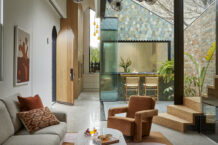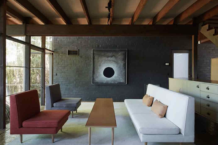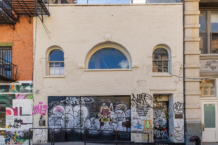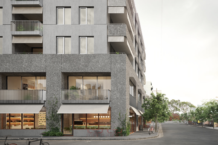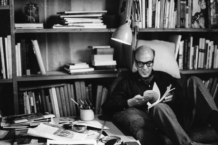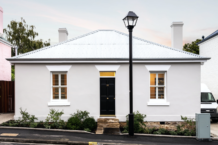Welcome to Radelaide
Design, Open Musings - by Simeon King
Having lived his first 20 years in Adelaide and his second in the Emerald City of Sydney, Simeon King is the insider’s outsider. With new eyes on his old city he is finding hope, life and detail in the fine grain of the grand old lady of Adelaide.
Adelaide is a city of a million, on the edge of the desert, surrounded by low lying hills and gulf waters. It is the perfect twenty minute city but it has some real challenges finding itself in the 21st century. There is change in the air however, there are more creative entrepreneurs staying put who genuinely love their city and new events and efforts being made to improve its day-to-day life. There’s plenty to love about it, and much to discover.

Welcome to Adelaide
Launched with some anticipated controversy, the new Brand SA welcomes you at the airport albeit with a whiteboard on wheels vibe. The brand designed by Melbourne maestro Ken Cato cleverly gets away with borrowing the rest of Australia to help locate South Australia in its origami red centre, as the sneaky back doorway into the country. Adelaide seems to have settled into a more comfortable position, perhaps starting to lose its need to compete with Melbourne or Sydney — with a new tagline and ambition to be ‘one of the world’s great small cities’. And it could be.
 Untethered trolleys
Untethered trolleys
With a bright shiny new airport and new entrance lanscape plaza and car park — it’s great to find a free luggage trolley, sans advertisements without the hassle of finding the right coins for the trolley machine. Thumbs up for laid back freedom and a free ride.
 Club Med
Club Med
Adelaide is renowned for its Mediterranean climate, one that is now being described as more North African (think Tunisia or Egypt) than Tuscany or Marseille.
Wild olives grow all over the park lands, metropolitan area, Adelaide Hills and outskirts. The post war Europeans were on to these years ago but now more and more locals are picking them in collectives and pressing their own feral oils. These olives were being picked in McLaren Vale for the Aldinga Feral 2013 pressings.
 Oi You Radelaide!
Oi You Radelaide!
Like Brisvegas—and at about the same time—Adelaide picked up the rather tongue–in–cheek “Radelaide” nickname, which is a fair bit better than “Delayed”. Adelaide is the only state capital named after a woman, Queen Adelaide. The inaugural six week Oi You! Adelaide Urban Art Festival just finished on June 2nd.
 Don’t cross the King
Don’t cross the King
Adelaide CBD is a very regular grid laid out by Colonel Light in 1836. The main ceremonial and public transport corridor is King William Street. According to myth all the perpendicular east–west streets changed names from one side of King William Street to the other, as you weren’t allowed to ‘cross the King’. In fact it was more likely that Light had more patrons and sponsors to commemorate and perpetuate their names in the new colony than he could fit, so he just divided the 2 mile streets in half.
 Car Parks are King (not Park Lands)
Car Parks are King (not Park Lands)
Adelaide City ‘square mile’ has more undercover car parking spaces (in parking stations) than any other city in Australia, both per capita (1 for every 27 people) and in total number (0ver 41,000) with another 15,000 or so on the street. And it’s cheap. Understandably public transport works hard to compete with private vehicle use — where road space is abundant, tolled roads don’t exist, housing density is low and parking dirt cheap. It is said Adelaide only has a peak half-hour, from 5.15–5.45 pm. On street parking fines are less than half of Sydney. Until they reach a bigger crisis, it’s hard to see Adelaide becoming Copenhagen anytime soon.
 Velo–city
Velo–city
Even with all the available car capacity the transport planners of Adelaide are starting to innovate, with new ‘road dieting’ measures and new bicycle lanes being constructed. Adelaide is perfectly suited to cycling with wide flat roads and plenty of places to stop off for coffee. The Lord Mayor Stephen Yarwood is starting to have an impact, and cycling is growing in popularity. In 2014 Adelaide is hosting the world’s premiere cycling conference from 27–30 May 2014, Velo-City.
.
 Green lanes growing
Green lanes growing
Brand new on-street bike parking and bike lanes on Pirie Street in the CBD.
 Sidewalk paving
Sidewalk paving
Recently Adelaide started replacing the fantastic concrete pavers with stone on the more prestige streets and malls. I’ve always had a soft spot for the cheaper concrete pavers, easily lifted and relaid — even if they have not worked out which way they should run.
 City of capacity
City of capacity
No need to share a seat on morning peak hour, when inner city buses are less than half full. Sydney and Melbourne can only dream. The fact that there are few bus priority measures or bus lanes means you sit in the same traffic as all the AM/FM listening commuters stuck in their cars in the next lane.
 The jewel in the crown
The jewel in the crown
For my money, the Adelaide Central Market is the best in Australia, and a rare place to rub shoulders with the locals — in a miniature city grid of three metre wide lanes where you can’t but feel compressed and charmed by the shouting fruit sellers, kids and nanna shopping carts. Great produce, cafes and specialty shops (Stinky Cheese Shop, Mushroom Shop, Honey Shop, Wild Loaf).
 Lucia’s Pizza and Spaghetti Bar est. 1957
Lucia’s Pizza and Spaghetti Bar est. 1957
When at the markets visit the old girl. Lucia’s has been around so long, and stuck to its knitting so that it has become almost a museum piece. It’s a great place to meet people and eat ham and cheese croissants, ricotta cake, minestrone, pizza and pasta. The coffee world has moved on a long way since but it’s still a decent coffee hang out. Cities with places of authenticity and longevity are better cities. Lucia’s wins hands down for its steadfast no-nonsense business model, unchanged for over half a century. Lucia’s children have also set up a fancy new Fine Food Store next door, with its own product range and Salumi Bar.
 They don’t have Fritz in Sydney
They don’t have Fritz in Sydney
More commonly known as Devon in the eastern states, bung Fritz is the great South Australian mystery meat, traditionally eaten with tomato sauce, and cherished in a 1980s ad for State Bank South Australia. Track it down at the delicatessen at the Adelaide Central Market.
 In the money
In the money
The Reserve Bank building is one of Adelaide’s more handsome post war buildings completed in 1960 by the Commonwealth Department of Works with architect Rolf Jensen. Built with double glazing, marble facade and concave east and west walls, it holds a commanding position in the north-east corner of Victoria Square, adjacent to the former Treasury Buildings (now the Adina Hotel). It was the southern bookend of the financial district centred around the old Stock Exchange which operated there from 1901—1991. The Reserve Bank building is now home to a new city site for Flinders University, based in the southern suburbs of Adelaide. It is one of the city’s great opportunities, to become the Oxford or Boston of Australia, a place full of students, innovation and ideas.
 The Museum of Buildings, Part 1
The Museum of Buildings, Part 1
Just down the street from the Reserve Bank is this lovely little building, Faraway House. With gorgeous pinned type on the parapet, the commercial office since the 1950’s it has withstood the tides of boom and bust, and remains a little guy in a faraway place.
 The Museum of Buildings, Part 2
The Museum of Buildings, Part 2
In the west end lies a plethora of amazing building stock, of all ages, all styles, many just waiting for a good idea – somehow dodging the bullet of redevelopment for another car parking station. Adelaide has a great array of stone and red brick buidings remaining in the CBD, some of it under threat from developers. Much of this fine grain building needs to be retained to keep Adelaide a real and interesting place. “We need to avoid making everywhere like everywhere else, rather than more like itself.” — Les Sparks, CABE Commissioner (UK)
 The Museum of Buildings, Part 3
The Museum of Buildings, Part 3
Ditto. Another gem on Eliza Street.
 The Museum of Buildings, Part 4
The Museum of Buildings, Part 4
Former Auctioneers Rooms, Penaluna Place
Next up, Radelaide Part Two: The new architecture, new venues and new sites emerging around town…
Words and images
by Simeon King
Urban planner, designer, researcher and founder of Public Associates
www.publicassociates.com
Instagram.com/simeonking


